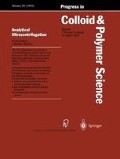Abstract
It is known that oligonucleosomal chromatin fragments from chicken erythrocytes enriched in inactive genes can self-associate into pseudo-higher-order structures. In this paper, we demonstrate the similar aggregation phenomenon for another type of repressed cells, sea urchin spermatozoa. Like the inactive part of erythrocyte chromatin, sea urchin sperm chromatin is characterized by the long linker DNA (100 base pairs) and the presence of specific histones typical for the repressed state of chromatin. It seems that these two factors determine the specific association of oligonucleosomes. The aggregates of sea urchin sperm oligonucleosomes resemble those of the erythrocyte chromatin in the following features: the range of the sizes of oligonucleosomes that are able to associate into pseudo-higher-order structures is limited; such self-association takes place at a low extent of the chromatin digestion by micrococcal nuclease; the aggregates undergo salt-induced compaction. Similarity in the properties of chromatin aggregates from two types of terminally repressed cells makes it possible to consider the specific association into pseudo-higher-order structures as a characteristic feature of chromatin from the inactive part of the genome.
Preview
Unable to display preview. Download preview PDF.
References
Renz M (1979) Nucl Acids Res 6:2761–2767
Ruiz-Carillo A, Puigdomenech P, Eder G, Lurz R (1980) Biochemistry 19:2544–2554
Stratling W, Klingholz R (1981) Biochemistry 20:1386–1392
Puigdomenech P, Ruiz-Carrillo A (1982) Biochim Biophys Acta 696:267–274
Thomas JO, Rees C, Pearson E (1985) Eur J Biochem 147:143–151
Thomas JO, Rees C (1983) Eur J Biochem 134:109–115
Muyldermans S, Lasters I, Hamers R, Wyns L (1985) Eur J Biochem 150:441–446
Weintraub H (1984) Cell 38:17–27
Grigoryev S, Spirin K, Krasheninnikov I (1990) Nucl Acids Res 18:7397–7406
Kamakaka RT, Thomas JO (1990) EMBO J 9:3997–4006
Osipova TN, Karpova EV, Konditerov SV, Vorob'ev VI (1990) Molec Biol 24:69–78
Zalenskaya IA, Pospelov VA, Zalensky AO, Vorob'ev VI (1981) Nucl Acids Res 9:473–486
Von Holt C, Strickland WN, Brandt WF, Strickland MS (1979) FEBS Lett 100:201–218
Vorob'ev VI, Karpova EV, Osipova TN (1994) Biorheology 31:221–234
Van Holde KE (1989) Chromatin, Springer-Verlag, New York, pp 355–356
Osipova TN, Karpova EV, Vorob'ev VI (1990) J Biomol Structure & Dynamics 8:11–22
Osipova TN, Karpova EV, Ramm EI, Svetlikova SB, Poselov VA (1986) Molec Biol 20:853–861
Butler PJG, Thomas JO (1980) J Mol Biol 140:505–529
Thomas JO, Rees C, Butler PJG (1986) Eur J Biochem 154:343–348
Hill CS, Rimmer JM, Green BN, Finch JT, Thomas JO (1991) EMBO J 10:1939–1948
Clark DJ, Thomas JO (1988) Eur J Biolchem 178:225–233
Osipova TN, Triebel H, Bar H, Zalenskaya IA, Hartmann M (1985) Molec Biol Rep 10:153–158
Osipova TN, Vorob'ev VI, Bottger M, Von Mickwitz C-U, Scherneck S (1982) Molec Biol Rep 8:71–75
Bates DL, Thomas JO (1981) Nucl Acids Res 9:5883–5894
Kamakaka RT, Thomas JO (1990) EMBO J 9:3997–4006
Author information
Authors and Affiliations
Editor information
Rights and permissions
Copyright information
© 1995 Dr. Dietrich Steinkopff Verlag GmbH & Co. KG
About this paper
Cite this paper
Karpova, E.V., Osipova, T.N., Vorob’ev, V.I. (1995). Sedimentation studies of specific association of oligonucleosomes from sea urchin sperm chromatin. In: Behlke, J. (eds) Analytical Ultracentrifugation. Progress in Colloid & Polymer Science, vol 99. Steinkopff. https://doi.org/10.1007/BFb0114070
Download citation
DOI: https://doi.org/10.1007/BFb0114070
Received:
Published:
Publisher Name: Steinkopff
Print ISBN: 978-3-7985-1038-8
Online ISBN: 978-3-7985-1666-3
eBook Packages: Springer Book Archive

